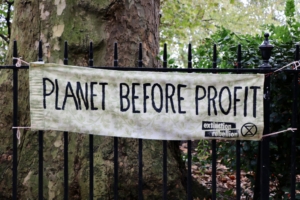What’s in the Pipeline
Here’s What You Need To Know
Over the past few weeks, big developments in the energy world have been cause for both concern and celebration among its advocates. Significant court victories have cleared the way for some key infrastructure projects, while other judicial losses serve as a powerful reminder of how traditional energy opponents have become professionalized, backed with substantial financial support and technical expertise that allows them to “run out the clock” by burying energy companies in administrative and legal compliance costs.
Despite this organized obstruction, getting energy infrastructure projects built with a minimum of delay and disruption is crucial for our economy, and an unexpected announcement this week by the Oracle of Omaha himself made clear traditional energy infrastructure is here to stay. With that in mind, here’s what public affairs professionals need to know to successfully navigate the new operating landscape and defend the significant investments their firms are making in communities before their opponents arrive.
Recent Court and Legal Actions Have Buffetted Energy Infrastructure Projects Across the Country
Atlantic Coast Cancelled. In mid-June, the U.S. Supreme Court handed down a 7-2 decision that the Trump Administration behaved lawfully in approving construction of the Atlantic Coast Pipeline. That left some observers surprised last weekend when project owners Dominion and Duke Energy announced that “legal uncertainty” has forced them to cancel construction of the long-sought project. The new reality of energy activism explains their decision, with the companies telling CNN, “ongoing delays, litigation, and an expected increase in costs” threatened the viability of their project, which had already cost well over a million dollars in unexpected lobbying and litigation costs over the past several years.
Subscribe to Receive Insights
"*" indicates required fields
Dakota Access Ordered To Be Drained. News of Atlantic Coast’s cancellation was quickly followed by a U.S. District Court judge ordering the Dakota Access Pipeline to be emptied no later than August 5, 2020, as it awaits a new governmental review. The delay marks a major victory for a carefully crafted coalition of environmental activists and Native American groups who have long fought against the pipeline’s construction and use. While pipeline owner Energy Transfer has made clear it will appeal this ruling, the decision highlights how activists can continue to disrupt projects even after they go in service.
Michigan AG Targets Line 5 With New Strategy. Last week, a Michigan judge allowed Enbridge to resume pumping oil through its Line 5 pipeline following a brief shutdown after damage to a structure anchoring part of the line running through a Great Lakes channel. Despite this victory, state Attorney General Dana Nessel has adopted a new strategy against the pipeline: revoking a seven-decade old easement for the 540,000 barrel-per-day pipeline by “wrest[ing] questions about the safety of pipeline from the federal Pipeline and Hazardous Materials Safety Administration [PHMSA].” While Enbridge’s attorneys note, “Unlike the Attorney General, PHMSA has the expertise necessary” to determine the pipeline’s safety, Nessel’s office hopes the easement will be viewed as a private contract that does not need PHMSA’s input. As well-known pipeline activist Jane Kleeb noted to Politico, Nessel’s “strategy could create leverage for state governments against pipeline projects in the permitting process and already completed.”
But Hope Springs From Omaha… Despite these setbacks to the industry, earlier this week, Berkshire Hathaway announced that it will buy Dominion Energy’s gas pipeline network, giving Berkshire control of 18 percent of natural gas pipelines across the US. It was Warren Buffett’s first major purchase since the onset of the pandemic, making this move a significant indication that he believes natural gas has a long-term future despite activist cries to the contrary.
… And The Supreme Court’s Permit 12 Decision: In an April court case challenging the Keystone XL pipeline’s permitting, the U.S. District Court for Montana decided the U.S. Army Corp of Engineers (the Corps) wrongly issued the Nationwide Permit 12 (NWP 12). NWP 12 is an important permit because it is used to authorize “the construction, maintenance, repair and removal of utility lines and associated facilities in waters of the United States, provided the activity does not result in the loss of greater than 1/2-acre of waters of the United States.” When the Corps issued NWP12, it estimated that it would be used for “11,500 projects per year,” making it a crucial permit relied on by numerous developers. Earlier this week, the U.S. Supreme Court overruled the lower court and reinstated the permit. Although the Supreme Court’s decision did not renew the use of the permit for Keystone XL, the ruling is positive news for the oil and gas industry across the country.
Getting Projects Built Has Gotten Harder Because the Opposition Has Become More Strategic, and More Prepared To Take Their Fights to the Courts
NIMBY Has Become NIABY (Not In Anyone’s Back Yard). Today’s activists are mobile – willing and able to go wherever they need to fight energy infrastructure, and are taking their well-funded guerilla warfare across the globe. Canadian activist Ocean Hyland is symbolic of the young people driving the anti-pipeline movement, traveling from protect actions against the Trans Mountain Pipeline in British Columbia to a London protest against Barclay’s bank funding of pipelines. Likewise, numerous activists flooded into North Dakota from across the country during the 2016-2017 protests against the Dakota Access Pipeline.
Professionalized, Digitized, and Strategic. Today’s next generation activists have more professional backing and support, know how to leverage digital tools to spread their messages far and away, and strategically target projects and companies. In addition, groups like Extinction Rebellion and 350.org are far more willing to use disruptive tactics than the more tradition environmental groups and are willing to wait out a project as long as needed to outlast developers.
Lawyered Up With Billionaire Backing. Just one example of the professionalization of protesting are efforts by well-funded environmentalist groups like the Environmental Defense Fund to back local environmentalists with expert attorneys dedicated solely to their cause. Another such organization, Earth Justice, employs 148 lawyers at 14 regional offices who are in the midst of 661 active legal proceedings on behalf of environmental interests. Aspiring lawyers wishing to pursue the environmental activism track have plenty of resources at their disposal as well, such as the NYU State Energy & Environmental Impact Center, which uses funding from Bloomberg Philanthropies to “provide legal, analytical, and communications support to state attorneys general offices across the country.” The Center even pays the salaries for law fellows placed in AG offices across the country. These groups ensure activists have the resources to continue fighting for years with sophisticated legal arguments as essential infrastructure remains mired in courtrooms and project costs balloon.
To Succeed, Energy Companies Must Understand and Engage Each Community – Before the Opposition Mounts
Understand the Landscape and Act Quickly to Engage The Right Stakeholders: In order to move forward with important projects, energy companies must understand the landscape of each community and mobilize long before their opponents can. This involves listening not only to the concerns of local leaders and residents but also tracking the tactics commonly used by opponents in similar situations. Companies and coalitions simply cannot wait until these professional activists have already influenced the communities they need to convince to support their project.
Define Your Own Brand: Companies must be in the communities they operate in before their opposition shows up. Companies need to tell their story and be constantly engaging with communities before they can be defined by those opposed to them, because as the old political adage says, “if you’re explaining, you’re losing.” Today, infrastructure builders have to consider their brand, and introduce it on their terms in a way that was not necessary in decades past. If a company is able to tell their story early and often, and secure a community’s trust, they can better control the narrative when the activists arrive.
Staying Prepared and Alert: In recent years, online interconnectivity has created a support network that allowed environmental activists to instruct and fund each other, organizing from the smallest towns to the biggest cities. As a result, each energy project faces unique opposition from opponents who both live locally and collaborate nationally. This new reality means energy companies must be prepared to adapt to localized fights that are informed by national tactics and funded by outside interests. A competitive intelligence advantage from Delve can help companies and coalitions understand the landscape of each individual fight, arming them with the information necessary to get projects built.



